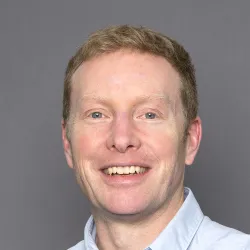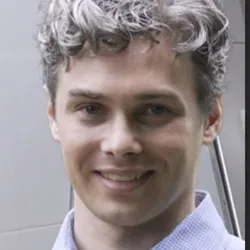Ushering in a new era of biomedical discovery through computational innovations

From identifying the origins of disease and unravelling the secrets of the brain, the Centre for Computational Biomedical Sciences (CCBS) at the John Curtin School of Medical Research (JCSMR) is on a mission to usher in a new era of biomedical discovery through computational innovation.

CCBS encompass an interdisciplinary research centre at the ANU by melding many innovative computational approaches from gene decoding to unveiling cell behaviour.
Established in 2022, the CCBS is headed by Professor Eduardo Eyras. “CCBS is innovating in computational science to broaden its impact in biomedicine and improve human health,” said CCBS Director Professor Eduardo Eyras.
CCBS and their leaders are also taking the lead in training future minds in computing for biomedical discovery to pioneer in future medicine.
A Collaborative Catalyst for Innovation with Data Science


CCBS fosters a vibrant research environment integrating a wide range of activities, from decoding gene function to mapping sub-cellular processes. The combination of deep biological understanding and expert data with computational science has enabled academic and professional CCBS teams to participate and lead projects of national significance supported by competitive funding. One such project is co-developing the biomedical data asset by the research and infrastructure teams led by Philip Wu (APF Informatics) and Cameron Jack (ANU Bioinformatics Consultancy). They combined forces with Monash University researchers to co-develop the biomedical data asset (bda.phenomicsaustralia.org.au) as part of the ARDC’s Cross-NCRIS data sharing initiative, joining together existing data resources of Phenomics Australia and BioPlatforms Australia.
“BDA is a first-of-its-kind human-to-mouse model linkage of data from whole-organism phenotype through to individual nucleotide-base DNA changes, extending groundbreaking work begun by the Monarch Initiative from Broad Institute and Google Labs. Understanding the properties of different data types is essential for bridging the limits each would normally impose in linking and presenting information,” says Cameron Jack (ANU Bioinformatics Consultancy), “We were able to make reasonable compromises to balance today’s computational cloud capabilities with the scale of data that is now available in the genomics space.”
From Bench to Bedside: Translating Innovation into Impact through Computation

Volumetric imaging of actin distribution of spheroids, Left - Standard (confocal), Right - With Computational Optics.

CCBS goes beyond theoretical exploration, focusing on the practical application of computational biology across multiple research areas. A key goal is unveiling cellular secrets in living tissue, deciphering the intricate workings of healthy and diseased tissues at multiple size scales using computational tools that can innovate spatial biology technologies for different novel therapeutic interventions.
“Computational imaging, once confined to physics laboratories, is now permeating the field of biomedicine. My team is actively working with established industry partners on translating our unique computational tool called Spatial Adaptive Imaging to transform single-cell technologies across a wide range of platforms, from microscopy to cytometry and spatial transcriptomics, and be readily deployed in pathology clinics,” says Steve Lee, PhD, leader of the Optical Biofluidic Group at JCSMR.
Precision medicine approaches from large biological datasets
Research within the CCBS harnesses the complexity of large genomic and medical datasets through sophisticated computational tools, including machine learning and artificial intelligence algorithms. The work of CCBS researchers builds both diagnostic and decision support systems to translate research into patient care. This activity is an iterative, team-driven process that includes patients, clinician-scientists, computational biologists, and machine-learning specialists.

Visualisation of dimensionality reduced representations of human cell population data from diseased patients in a single family. Identification of increases or absences of cell types in patients allows identification of the cellular systems perturbed in certain diseases.

“The increasing availability of large biological and clinical datasets in biomedicine is a huge opportunity to identify better treatments of human disease. With increased molecular and clinical information about patients – and this may include their genome sequence and/or detailed laboratory data that describes their condition - we can identify more precisely the origins and evolution of the disease in an individual. This is the first step towards precision medicine and developing tailored treatments for individual patients,” says Associate Professor Dan Andrews, PhD, leader of the Genome Informatics Laboratory at JCSMR and Joint Jubilee Fellow at the ANU School of Computing.
Scientific Excellence Recognised

CCBS's impactful research is reflected in its highly cited publications in top journals like Nature, Cell Reports, and Nature Communications. Their research innovation has also garnered over $20 million in funding from National and International organizations in the last 2 years, highlighting the potential and significance of their endeavours. Most prominently, CCBS researchers Associate Professor Jiayu (Jean) Wen, PhD and Professor Eduardo Eyras, PhD are members of the ARC Centre of Excellence for the Mathematical Analysis of Cell Systems (MACSYS), a 7-year research program bringing together an interdisciplinary team of researchers from across Australia to model and design how cells function using mathematical, machine-learning, engineering as well as experimental approaches.
“This initiative will deepen our understanding of life's complexity at the cellular level and empower us to design and engineer biological systems more effectively,” says Jiayu (Jean) Wen, PhD, the MACSYS ANU node lead, head of the Computational Biology of RNAs and Functional Genomics at JCSMR, and Deputy Director of the Shine-Dalgarno Centre for RNA Innovation.
Training the Future Workforce in Computational Biomedicine
The CCBS spearheads innovative training and mentoring programs in computational biology. The Talo Computational Biology Talent Accelerator, a pioneering ANU flagship program led by the CCBS, aims to support research and training in computational biology, empowering future generations of computational biologists through multiple scholarships and grant schemes to solve biomedical problems using advanced computer science.
The Talo Computational Biology Talent Accelerator (Talo Program) was established to attract undergraduate and graduate students with strong computational training to conduct cutting-edge computational biomedicine research at JCSMR in close interaction with biomedical researchers and with the objective of applying and developing novel computational methods to address real-world biomedical problems. So far, the program has funded 4 full and 3 top-up PhD scholarships, 6 innovator grants, and 4 undergraduate training awards. Furthermore, the Program launched its travel grant scheme in 2024 for early career researchers to visit companies and academic institutions anywhere in the world.
“The Talo program provides a unique opportunity for interdisciplinary training and for developing innovative computational technologies that are relevant to biomedical research. With this program, we aim to train a new generation of researchers that can thrive across multiple areas, communicate effectively with computational and biomedical experts, and drive future advances in biology and biomedicine,” says Professor Eduardo Eyras, head of the Computational RNA Biology Group at JCSMR and CCBS Director.
Driving and fostering interdisciplinary research

“We are increasingly leveraging AI and machine learning to disentangle complex patterns of brain activity in large neuroscience datasets. This is bringing us closer to understanding how information is encoded and processed in the brain, and how neural computational is affected by factors such as age, experience or neurodevelopmental disorders," says Michael McCullough, PhD, leader of the Computational Neuroscience Group at JCSMR and Joint Jubilee Fellow at the ANU School of Computing.
CCBS researchers are leading academic activities to foster interdisciplinary research and innovation. Dr Michael McCullough and Dr Daniel Andrews are looking to gather like-minded individuals to discuss the impact of AI in Biology aiming to promote collaborations across ANU research schools and enable innovation and discovery in biomedical research.
Pioneering the Future of Medicine

CCBS continues to push the boundaries of scientific exploration, their unwavering dedication to collaborative research and impactful translation promises to unlock a new era of medical discovery, ultimately improving health outcomes for all.
